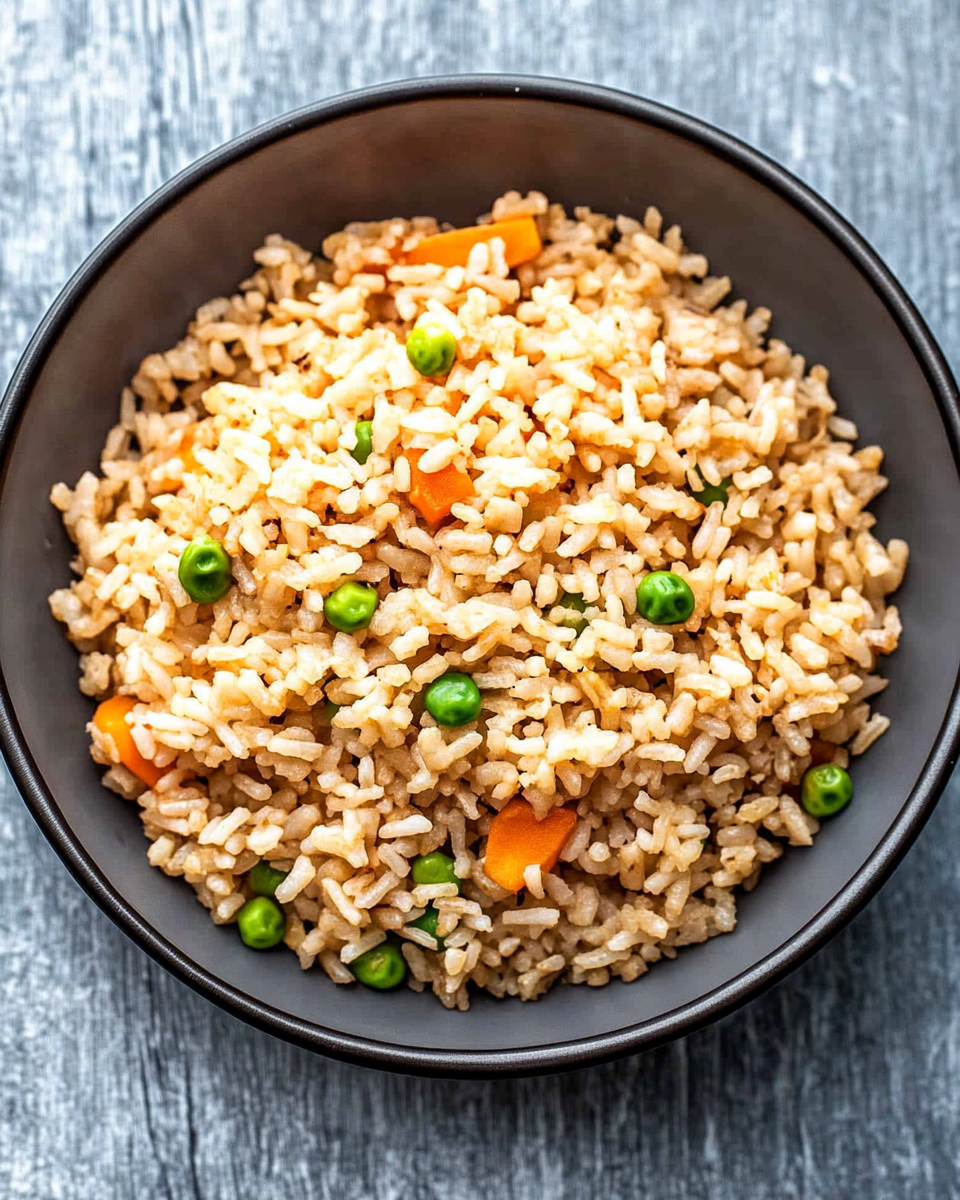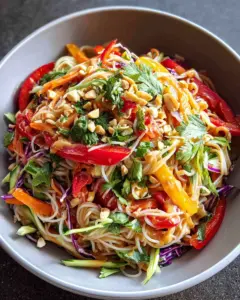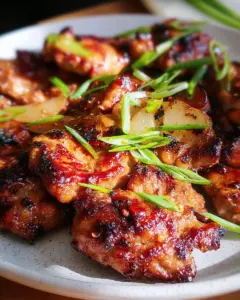Few dishes are as universally loved as fried rice. This hibachi-style fried rice recipe delivers the savory, buttery flavors of restaurant-quality fried rice with minimal effort. The key lies in using cold, day-old rice, which fries up light and fluffy instead of turning mushy. A simple soy-butter blend coats every grain, while a mix of carrots, peas, and onions adds color and texture. Whether you need a quick weeknight dinner or a crowd-pleasing side dish, this recipe is endlessly adaptable and ready in under 30 minutes.

Preparation Phase & Tools to Use
To make perfect fried rice, having the right tools makes all the difference. A large wok or heavy-bottomed skillet is ideal because it distributes heat evenly and provides enough space to toss ingredients without spilling. If you don’t have a wok, a non-stick skillet works well too—just ensure it’s large enough to hold all the ingredients without overcrowding.
A wooden or silicone spatula is essential for breaking up rice clumps and stirring without scratching the pan. You’ll also need measuring spoons for precise seasoning and a few mixing bowls to prep ingredients beforehand. Unlike stir-fries that require constant high heat, fried rice benefits from controlled cooking, so a medium-high heat setting works best for most home stoves.
Importance of Each Tool
- Wok vs. Skillet: A wok’s curved shape helps toss ingredients efficiently, while a skillet is more accessible for beginners.
- Cold Rice: Refrigerated rice has less moisture, preventing a gummy texture when fried.
- Softened Butter: Mixes smoothly with soy sauce for even flavor distribution.
Preparation Tips
- Rice Prep: Cook rice at least 4 hours ahead (or use leftovers) and refrigerate uncovered to dry it slightly.
- Veggie Consistency: Dice carrots and onions into small, uniform pieces so they cook evenly.
- Mise en Place: Have all ingredients prepped before heating the pan—fried rice cooks fast.
Ingredients
- Rice & Protein:
- 4 cups cold cooked white rice (short-grain or jasmine)
- 1 large egg, lightly beaten
- Vegetables:
- ½ cup diced carrots (fresh or frozen)
- ½ cup peas (frozen recommended)
- ½ cup chopped white onion
- Sauces & Fats:
- 4 tablespoons unsalted butter, softened
- 2 tablespoons low-sodium soy sauce
- 2–3 tablespoons neutral oil (peanut, canola, or vegetable)
- 2 teaspoons sesame oil (optional, for finishing)
Step-by-Step Instructions
- Cook the Rice:
Prepare rice according to package instructions, then spread it on a tray to cool. Refrigerate for at least 1 hour (or overnight) to firm up. - Prepare the Soy-Butter Blend:
Soften butter (10 seconds in the microwave if needed), then mash with soy sauce. It may not fully combine, which is fine. - Scramble the Egg:
Heat 1 teaspoon oil in a wok over medium heat. Add the beaten egg, let it set slightly, then scramble into small pieces. Transfer to a plate. - Sauté the Vegetables:
Add another teaspoon of oil to the wok. Stir-fry carrots, peas, and onion for 3–4 minutes until tender but crisp. Season with a pinch of salt and pepper. Remove and set aside with the egg. - Fry the Rice:
Increase heat to medium-high. Add 1 tablespoon oil and the cold rice. Break up clumps with a spatula and stir every 30 seconds for 4–5 minutes until lightly toasted. - Season and Combine:
Drizzle the soy-butter mixture over the rice, tossing until fully coated. Return the cooked veggies and egg to the wok. Add sesame oil if using, and stir to combine. Taste and adjust seasoning with extra soy sauce if needed.
Variations:
- For extra protein, add diced chicken, shrimp, or tofu.
- Spice it up with a dash of sriracha or chili garlic sauce.
- Substitute soy sauce with coconut aminos for a sweeter, gluten-free version.
Fried rice is a versatile dish that can stand alone as a satisfying meal or complement a variety of sides. Whether you’re serving it as part of a larger spread or enjoying it as a quick dinner, presentation and pairing can elevate the experience. Additionally, avoiding common pitfalls ensures your fried rice turns out flavorful and perfectly textured every time.
Serving Suggestions
The beauty of hibachi-style fried rice lies in its adaptability. Here are a few ways to serve it for maximum appeal:
- Garnish for Visual and Flavor Boost
A sprinkle of sliced green onions adds freshness, while toasted sesame seeds provide a nutty crunch. For a touch of heat, drizzle with sriracha or serve with chili crisp on the side. A wedge of lime can brighten the dish with a hint of acidity. - Sauces for Dipping or Drizzling
While the soy-butter blend already packs plenty of umami, additional sauces can enhance the dish. Yum yum sauce (a creamy, slightly sweet Japanese condiment) or a simple ginger-scallion oil pairs wonderfully. For a richer option, mix mayonnaise with sriracha for a spicy, creamy drizzle. - Protein Toppings
Turn this side dish into a main course by topping it with grilled shrimp, teriyaki chicken, or seared tofu. Leftover roast pork or char siu (Chinese BBQ pork) also makes an excellent addition.
Common Mistakes to Avoid
Even experienced cooks can run into issues when making fried rice. Here’s how to sidestep the most frequent errors:
- Using Freshly Cooked Rice
Warm rice contains excess moisture, leading to a mushy, clumpy texture. Always use cold, day-old rice for the best results. If you’re in a hurry, spread freshly cooked rice on a baking sheet and chill it in the freezer for 20–30 minutes. - Overcrowding the Pan
Adding too much rice at once lowers the pan’s temperature, causing the rice to steam instead of fry. Work in batches if necessary, and ensure each grain has contact with the hot surface. - Insufficient Heat
Fried rice needs medium-high to high heat to develop that signature slightly crispy texture. If your stove runs cool, preheat the pan for an extra minute before adding ingredients. - Overloading with Sauces
Too much liquid (soy sauce, oyster sauce, etc.) can make the rice soggy. Start with a small amount, toss well, and add more only if needed. - Neglecting to Season in Layers
Lightly seasoning the vegetables and eggs as you cook them ensures balanced flavor throughout. Don’t rely solely on the final soy-butter mixture.
How to Perfect the Recipe
For restaurant-quality results every time, keep these expert tips in mind:
- Toast the Rice
After adding the rice to the pan, let it sit undisturbed for 30–45 seconds before stirring. This creates a slight crust, enhancing texture. - Use the Right Oil
Neutral oils like peanut or vegetable oil have high smoke points, ideal for frying. Save sesame oil for finishing—its low smoke point makes it unsuitable for high-heat cooking. - Prep Ingredients in Advance
Fried rice cooks quickly, so having everything measured and chopped beforehand prevents overcooking or burning. - Balance Flavors at the End
Taste the finished dish and adjust with a splash of soy sauce, a pinch of sugar, or a squeeze of lime if needed.
Side Dish Recommendations
Fried rice pairs beautifully with a range of sides. Here are eight options to complete your meal:
- Miso Soup – A light, savory broth that complements the richness of fried rice.
- Hibachi Vegetables – Grilled zucchini, mushrooms, and onions add smoky depth.
- Egg Rolls or Spring Rolls – Crispy appetizers that contrast the soft rice.
- Cucumber Salad – A refreshing, tangy counterbalance to the dish’s richness.
- Teriyaki-Glazed Protein – Chicken, salmon, or tofu with a sweet-savory glaze.
- Steamed Edamame – A simple, protein-packed starter.
- Kimchi – Spicy fermented cabbage for a punch of flavor and probiotics.
- Seaweed Salad – A briny, umami-rich side that enhances the dish’s Japanese influence.
Perfecting fried rice doesn’t end with cooking—how you store, reheat, and tweak the recipe can make all the difference. This section covers essential aftercare, troubleshooting, and answers to common questions to ensure your fried rice remains delicious from the first bite to the last.
Recipe Tips for Flawless Results
- Optimal Rice Texture
For the best crispy yet tender texture, press the rice firmly into the pan for 30-60 seconds before stirring. This creates a golden crust while keeping the interior fluffy. If the rice sticks, add a teaspoon more oil—but avoid over-greasing, which can make the dish heavy. - Flavor Enhancements
A pinch of white pepper or garlic powder blended into the soy-butter mixture adds depth. For umami richness, stir in ½ teaspoon fish sauce or 1 tablespoon oyster sauce (reduce soy sauce accordingly). Fresh grated ginger (1 teaspoon) brightens the dish when added with the vegetables. - Protein Variations
For meat lovers:- Toss in diced ham or Chinese sausage (lap cheong) with the rice.
- Leftover rotisserie chicken or roast pork works beautifully—add it when combining ingredients to prevent drying.
Vegetarian? Swap the egg for crumbled firm tofu sautéed with turmeric (for color).
- Vegetable Substitutions
Replace peas with edamame or corn kernels. Thinly sliced bell peppers or bok choy add crunch. For low-carb versions, use cauliflower rice (squeeze out excess moisture first).
Storage and Reheating Instructions
- Refrigeration
Store cooled fried rice in an airtight container for up to 3 days. To prevent dryness:- Place a damp paper towel over the rice before sealing.
- Avoid freezing—thawed rice grains often turn gritty.
- Reheating Methods
- Stovetop (Best for Texture):
Heat 1 teaspoon oil in a skillet over medium. Add rice and 1 tablespoon water, breaking up clumps. Cover for 2 minutes, then uncover and stir until hot. - Microwave (Quick Fix):
Transfer rice to a microwave-safe bowl. Cover with a damp paper towel and heat in 30-second intervals, fluffing between bursts.
- Stovetop (Best for Texture):
- Food Safety Note
Discard fried rice left at room temperature for over 2 hours. Reheat only once to avoid bacterial growth.
Frequently Asked Questions
Can I use brown rice or quinoa instead?
Yes, but adjust prep:
- Brown rice: Chill for at least 4 hours to reduce moisture. Fry 1-2 minutes longer.
- Quinoa: Spread cooked quinoa on a tray to dry before refrigerating. Use extra oil to prevent sticking.
Why does my fried rice taste bland?
Underseasoning is likely. Fix it by:
- Adding ½ teaspoon salt during vegetable cooking.
- Drizzling 1 teaspoon rice vinegar at the end for brightness.
- Garnishing with furikake (Japanese seasoning blend).
How do I prevent egg from disappearing into the rice?
Cook the egg first (as directed) and set it aside. Alternatively, push rice to the pan’s edges, scramble the egg in the center, then mix.
Is sesame oil necessary?
No, but it adds authentic nutty aroma. For substitutes, use 1 teaspoon toasted walnut oil or omit entirely.
Can I make this gluten-free?
Replace soy sauce with tamari or coconut aminos. Ensure all other sauces (like oyster sauce) are GF-certified.
How do restaurants get that smoky flavor?
They use high-BTU burners, but you can mimic it by:
- Letting the pan get very hot before adding rice.
- Adding ¼ teaspoon liquid smoke to the soy-butter mix.
Conclusion
Mastering hibachi-style fried rice is about technique as much as ingredients. From chilling the rice for the perfect texture to balancing flavors with soy-butter and sesame oil, each step builds toward a dish that rivals takeout. With these storage tricks, reheating hacks, and solutions to common issues, you’ll minimize waste and maximize taste. Whether you stick to the classic recipe or experiment with proteins and veggies, this versatile dish proves simple ingredients can deliver extraordinary results.
Final Tip: Double the recipe—leftovers (properly stored) make an excellent next-day lunch. For more global rice dishes, explore our Thai pineapple fried rice or Korean kimchi bokkeumbap guides.
Hibachi-Style Fried Rice
Ingredients
- 4 cups cooked short-grain white rice or long-grain/jasmine rice
- 1 egg whisked and scrambled
- ½ cup chopped carrots fresh or frozen
- ½ cup peas frozen recommended
- ½ cup white onion chopped
- 4 tablespoons unsalted butter softened
- 2 tablespoons low-sodium soy sauce
- 2 –3 tablespoons peanut canola, or vegetable oil
- 2 teaspoons sesame oil optional
Instructions
- Prepare the Rice
- Cook the rice according to package instructions.
- Chill in the refrigerator for at least 1 hour, preferably overnight, so it’s cold and firm for frying.
- Soften the Butter
- Let the butter sit at room temperature until soft, or microwave it in short intervals.
- Mash with a fork and mix in the soy sauce (don’t worry if it doesn’t fully combine).
- Cook the Egg
- Heat a splash of oil in a large skillet or wok over medium heat.
- Add the whisked egg and scramble into small chunks using a spatula.
- Remove and set aside.
- Cook the Vegetables
- Add another splash of oil to the skillet.
- Sauté carrots, peas, and onion for about 4 minutes, until tender. Season with a pinch of salt and pepper.
- Transfer to the plate with the scrambled egg.
- Fry the Rice
- Add more oil to the skillet and add the cold rice.
- Stir every 30 seconds to warm and lightly brown the rice, about 4–5 minutes. Adjust heat as needed.
- Season the Rice
- Drizzle the soy sauce-butter mixture over the rice.
- Toss until all grains are evenly coated and no white rice remains.
- Combine Everything
- Return the cooked veggies and scrambled egg to the skillet.
- Drizzle with sesame oil, if using, and stir to combine.
- Taste and adjust seasoning with more soy sauce if needed. Serve immediately.
- Notes
- Use cold, day-old rice to prevent clumping.
- Frozen peas and carrots are convenient; fresh vegetables work just as well.
- Start with low-sodium soy sauce; add more as needed.
- A wok is ideal for even heat and space, but a large skillet works too—just use plenty of oil.
- Keep ingredients moving in the skillet to avoid burning. Prepping all ingredients ahead of time makes cooking smoother.






